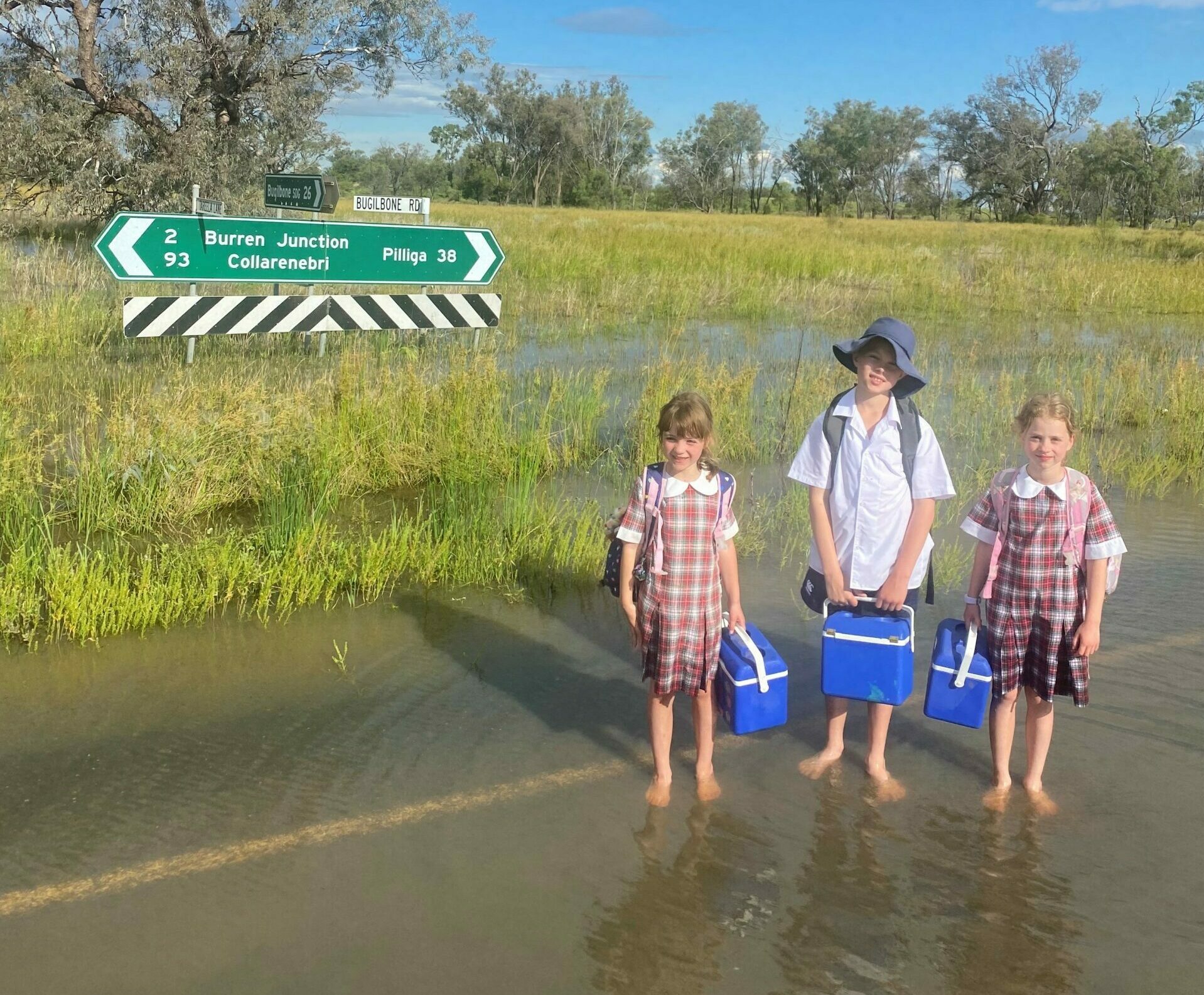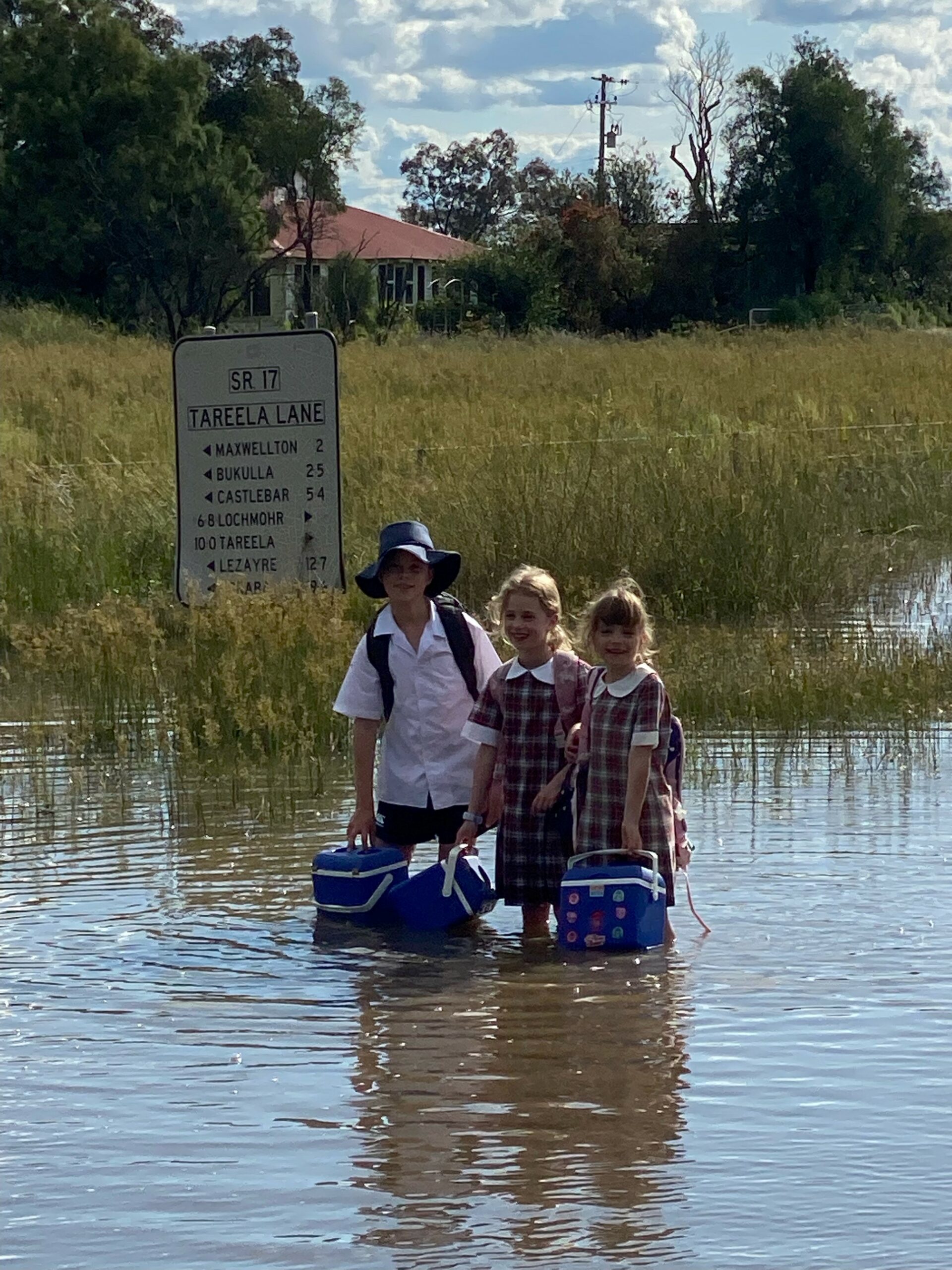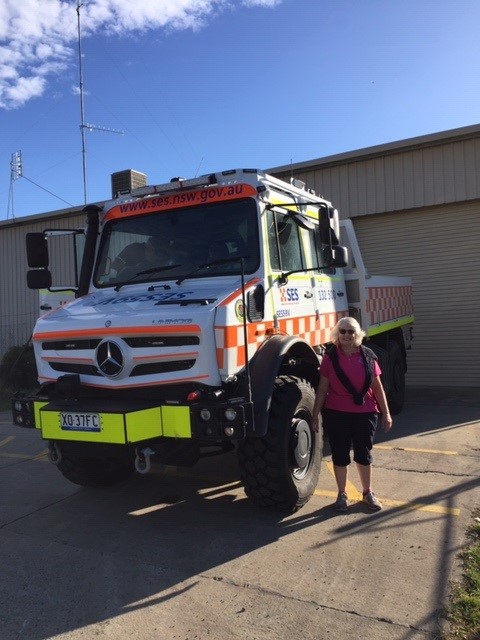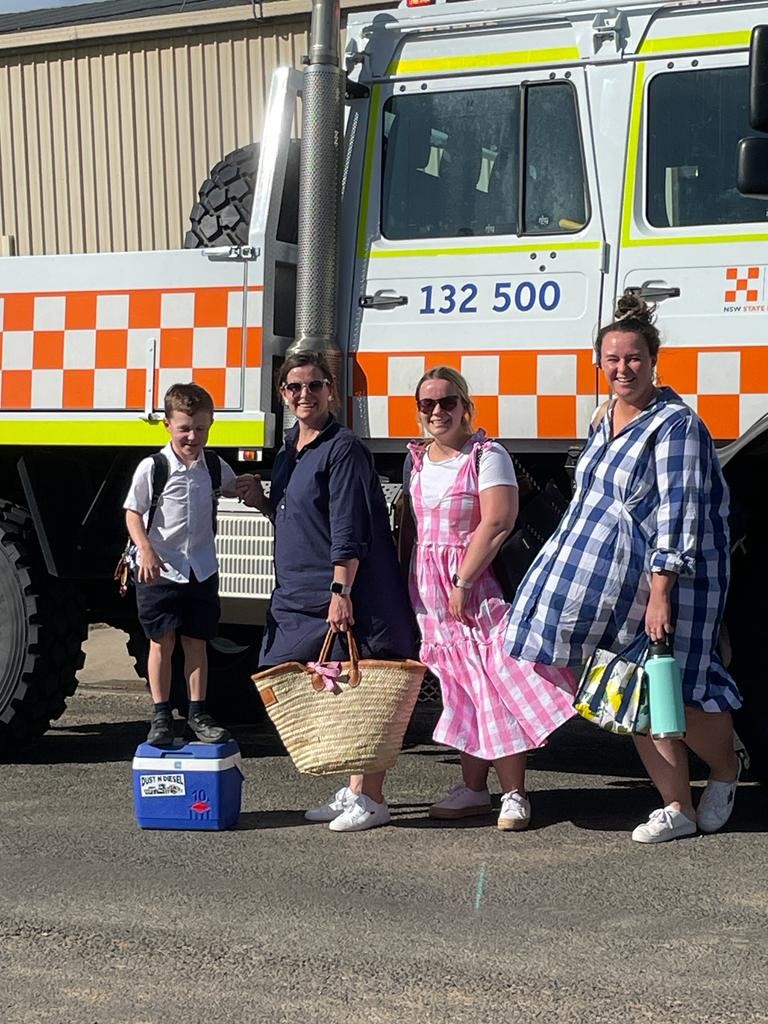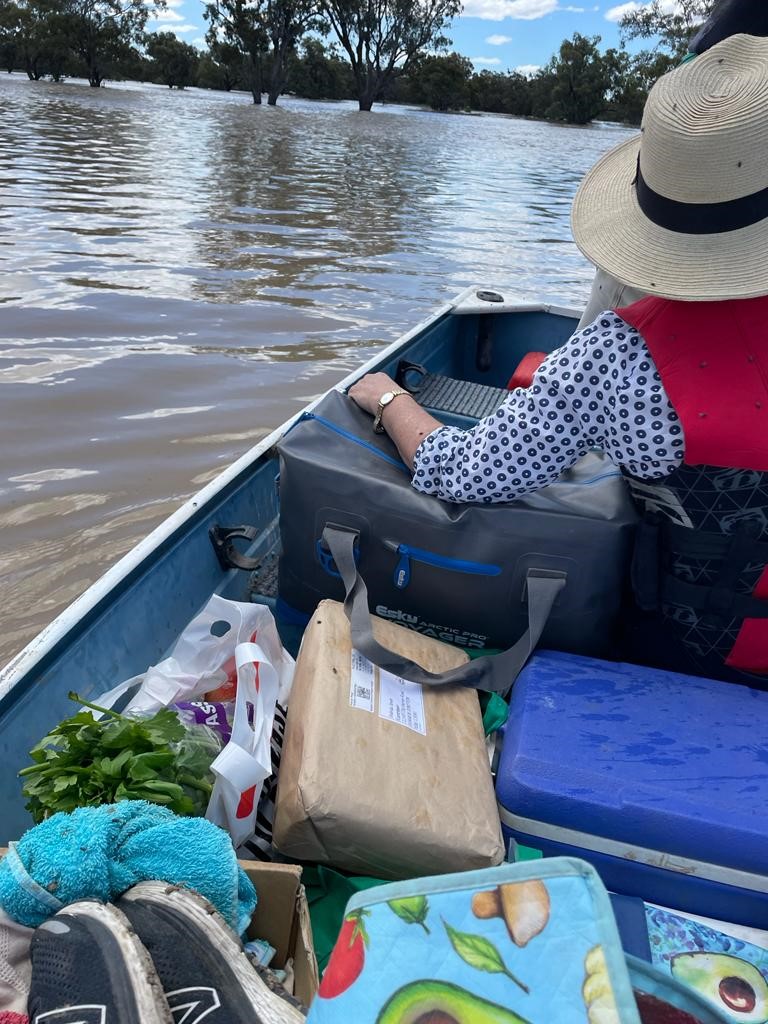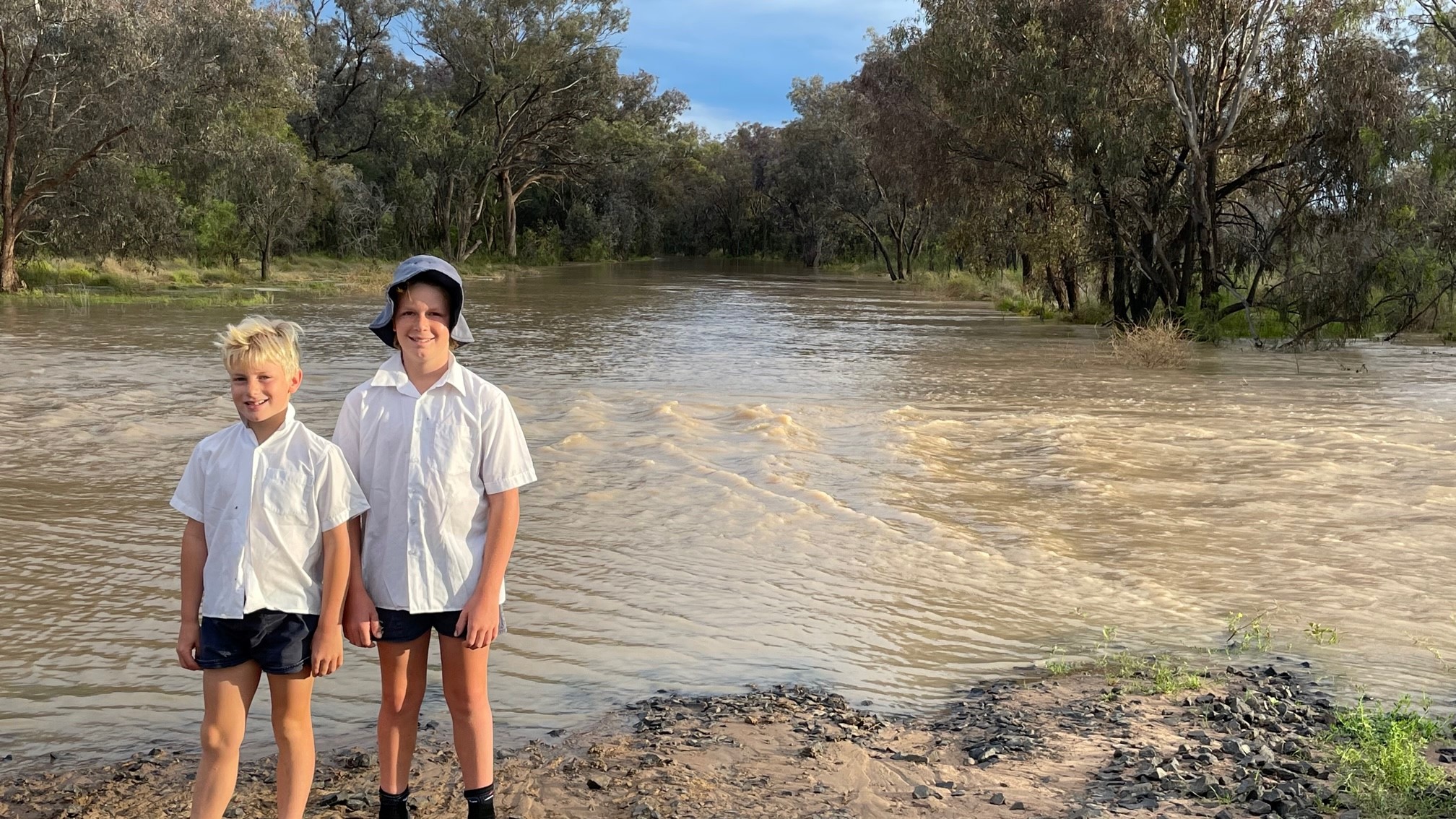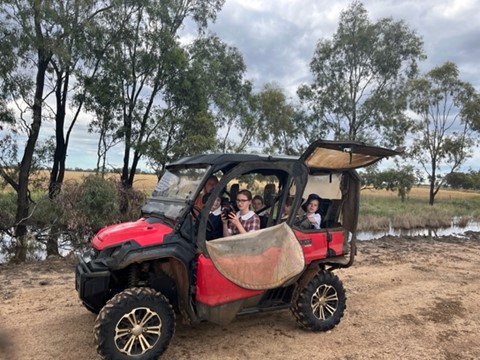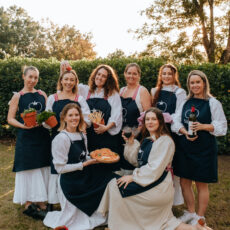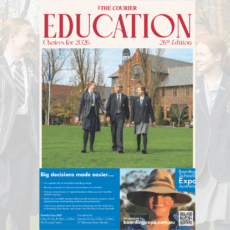Getting ready for school can be a chaotic time in most family households: the hustle and bustle of packing lunchboxes while eating breakfast, remembering library books, finishing homework, getting everyone dressed in the correct uniforms, and then racing to the bus stop before the bus arrives is no easy feat at the best of times.
So, when you throw a major flood into the morning routine mix, it’s fair to say the school run faces a whole new set of exhausting challenges, especially in a farming community cut off by floodwaters and on the black soil plains – notorious ground for bogging vehicles.
However, you won’t catch Burren Junction residents whingeing about it. The community is doing the best it can in a bad situation, banding together and coming up with collaborative and innovative ways to safely ferry students and teachers to the town’s school during the recent floods.
“I would say any student who went to school in Burren would have cherished memories and stories of their trips in the wet,” said Burren Junction Public School’s relieving principal Kate Slack-Smith.
The school is on dry land, but surrounding properties and roads have been inundated by water.
With most BJPS students and teachers living on farms, and four teachers based 50 kilometres west at Wee Waa, the modes of transport being used to get people to and from school include tractors, the State Emergency Services’ monster truck, a boat, four-wheel-drive buggies and even a chopper.
“It’s all about logistics,” said Mrs Slack-Smith, who lives on a farm about 30 kilometres down a black soil road from Burren with her husband Rodney and their children.
“The easy thing would be to say, ‘the school is closed’.
“But the school is open thanks to the great commitment of the staff, supported by the SES, bus drivers, farmers, and our community.”
Mrs Slack-Smith said it was her ‘highest priority’ to keep Burren Junction Public School operating for its 35 students and their families.
Providing a constant, fun, and familiar learning environment for children as many of their parents deal with the distressing impact of the floods on crops, stock, and livelihoods.
And, off the back of previous disruptions due to Covid restrictions, it’s no doubt good to have students back in the classroom and out of the house.
“The school is a service; we don’t have some services in Burren, we don’t have a shop to access milk and bread, but we do have a school, and we wanted to try to keep the school running,” said Mrs Slack-Smith.
“I had one staff member come by four-wheel-drive to meet the SES boat to get into Wee Waa. She then joined another two staff to come to Burren in the SES Unimog ‘monster truck’, as the kids call it.
“One student went home by chopper the other day because a tractor couldn’t get across to get her.
“There are families who have moved houses and are living in different houses to get their kids to school.
“It all shows the extraordinary measures they’re going to.
“We have 33 of the 35 students here today, and the two at home have Zoom-ed in for a story with (teacher) Lucinda Stump this morning and then will do online learning.
“And all our teachers are on deck.
“Everyone is trying to stay positive in what is an uncontrollable situation.”
Finding silver linings is something the region has become very good at doing throughout the recent years of ‘drought and flooding rains’, with a mouse plague in between and plenty of mozzies too.
However, there have also been bumper harvests and strong stock returns, a reminder of why life on the land can be so good and rewarding.
“Yes, it’s like we do everything here in extremes,” said Mrs Slack-Smith when asked about the different challenges.
“I think, to be honest; the floods are totally devastating – people have put drones up and we’ve seen the footage of all the crops underwater, properties underwater.
“But the thing you keep hearing is ‘the drought was worse’.
“I think, while this is devastating, everyone remembers those horrible years of drought so clearly.
“It’s hard to turn away rain, but I read and liked Jo Collett’s poem about being able to turn on and off the switch.
“There are generations before who had so many good years, our children have seen the land at its best and at its worst. I hope for their generation they have those good years if they decide to farm – I hope they have a dream run.”
Burren Junction has long been a farming community and like other agricultural areas hit by La Nina’s fury, the timing of the floods so close to harvest is absolutely heart-breaking for those impacted.
Farmers would’ve committed the finances needed to get their crops to this point in production, which makes losing them now a bitter pill to swallow.
It’s a different story on every farm; however, this year’s winter crop was tricky for some from the beginning with wet weather hampering sowing time, some crops had to be resown, and input costs such as fuel, fertiliser and chemical have been high.
According to a statement released by NSW Farmers, several agronomists were predicting ‘conservative’ losses of 120,000 hectares of wheat with an estimated value of between $108 million and $192 million as a result of widespread flooding in the Moree-Walgett-Narrabri area.
“The dollar value of the damage is on top of the $42 million it cost to grow the crop, which is now drowning beneath floodwater and may be a complete write-off if paddocks don’t dry out soon.”
NSW Farmers Grains Committee chair Justin Everitt said some farmers were calling it a ‘wet drought’.
“Farmers know they’re taking a bit of a gamble when they’re planting a crop, but this ongoing wet weather with flood after flood after flood is just unbelievable,” said Mr Everitt.
“You spend all this money preparing your paddocks, sowing your crops, fertilising and spraying them, only to see them wiped out a couple of weeks before harvest.”
Hopefully there will be farmers who can get crops off before floodwater seeps into paddocks, or surviving crops are downgraded by further rainfall.
The wet ground is also making it difficult to get machinery onto paddocks to harvest winter crops or to plant a summer crop, with the window for planting (or replanting) cotton getting smaller and smaller.
However, the resilience of those in the agricultural game and their amazing ability to bounce back from natural disasters is well-known.
School life carrying on in Burren reflects the farming community’s commitment to staying optimistic and working together to get on with the job.
Just like Mrs Slack-Smith and the dedicated BJPS staff.
The relieving principal has been fulfilling her role at school while enduring the tragic sight of promising crops submerged in water on her own farm.
Mrs Slack-Smith and her colleagues understand the blood, sweat and tears that go into growing a good crop and the high hopes of harvest, offering BJPS families a remarkable level of empathy because they’re all part of the same community and experience similar highs and lows.
“It does give you compassion for what people are going through.
“I’ve had a flooded farm, I’ve had the kids at home with Covid, I understand the struggles of getting to school when you have sick kids at home or kids at boarding school.
“All those challenges I face as well.
“But we are really lucky to have such a lovely community here.”
Mrs Slack-Smith has also been going above and beyond to travel into BJPS. Although, like her Burren neighbours, she takes the soggy and lengthy commute in her stride and says it’s all part of living in the bush.
“It would normally be a 20-minute trip, but at the moment, it takes about an hour to get to school – it’s 30 kilometres of black soil,” she added.
The impressive BJPS car-pooling (or buggy-pooling) mission begins at the Slack-Smith’s farm ‘Wyndella’ about 30 kilometres from town, where Mrs Slack-Smith and her daughter Sophie (a Burren student) jump in a side-by-side four-wheel-drive buggy, strap on their seatbelts and slosh down the black soil road collecting fellow student, Emmy Moore, along the way.
Next, the group meet up with Harry, Rachel and Maggie Powell waiting with their dad Christian at Tareela Lane. From here, they travel the final leg into Burren and arrive at school for the day, where their BJPS classmates would have similar muddy tales to share about their morning trips.
The mammoth effort is humbly handled with no fuss and a good sense of humour, especially when you consider they have to turnaround and do it all again when the school bell rings at the end of the day.
“There’s a line-up of gumboots at the front, a child might get off the side-by-side covered in mud, I had mud on my jacket the other day and didn’t realise, and nobody told me, but maybe it was because I looked a little tense,” added Mrs Slack-Smith with a laugh.
Rural families familiar with rain and flood events don’t seem to bat an eyelid at the extra stops, hurdles and time the wet weather adds to their daily commute, which along with the school run, can also involve juggling food and essential supply pick-ups, vehicle transfers at the bitumen, staying with friends and meeting neighbours en route to offer a helping hand or deliver goods.
“What’s changed is technology and side-by-sides have really revolutionised black soil trips in the mud,” said Mrs Slack-Smith.
“Some students used to be sent home with a suitcase, or their ‘wet weather pack’, to learn from home for the term.
“Burren was doing at-home learning long before COVID because of the wet.”
In typical Burren-style, the tiny town’s mighty community spirit is what’s been lifting morale as the water levels rise. And out of the flood deluge, heart-warming stories of kindness have emerged, giving locals a reason to smile.
A few weeks ago, Burren farmer and pilot John Stump (who also happens to be a former BJPS student) came to the rescue when Mrs Slack-Smith had travelled to Sydney for a school sports carnival just before the floods hit.
After 90 millimetres of rainfall near Burren, the Slack-Smiths decided it was best to divert to Armidale and stay with family until they could travel home safely.
“There would normally be three ways home from Armidale, but there was no way home; the roads were all closed.”
However, much to the relief of BJPS families reliant on their relieving principal, Mr Stump happened to be in Armidale and generously offered to fly Mrs Slack-Smith and Sophie home in his plane.
“It was not convenient for anyone, but it’s the sort of thing that makes Burren special,” said Mrs Slack-Smith.
“John was actually already in the air, but he didn’t hesitate and turned around to get us. We had 20 minutes to get to the airport.
“We made a plan to land on the airstrip at Sandy Stump’s farm, and then he kindly took us 15 kilometres in the side-by-side to meet Rodney at the Walgett Road and then we travelled home from there.
“We were very lucky.
“That’s what our community just does; everyone helps everyone.”
Mrs Slack-Smith had been in Sydney with four BJPS students, Will Smith, Bridie Harris, Frank Pike, and Sophie Slack-Smith. The students were competing in the small schools’ relay in the NSW Primary Athletics Championship, and in another good news story – they made it to the final and placed sixth.
“Our school has done so well this year, placing third at state in the swimming relay and sixth at state in the athletics relay,” said Mrs Slack-Smith.
“Three of the four kids were in both teams.”
Burren blitzing the sports field and a win at the North West Science and Engineering Discovery Day challenge earlier this year are just some of the positives the school community has been focusing on during this tough time. They’re great examples of how small schools in our district can achieve big things despite trying conditions.
“We’re really proud of the students.
“Our relay team making it to state was such a highlight – our oval isn’t even 400 metres, we haven’t had a dry 100 metres of land to train on for months, and we were practising baton changes while dodging puddles.
“What they’ve achieved is phenomenal.”


